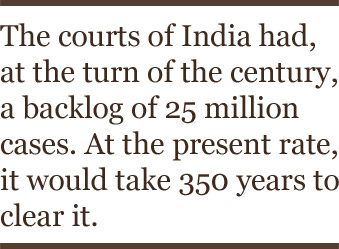Here are a few statistics from Suketu Mehta’s stunning new book, Maximum City. In some parts of Bombay, you can find 1 million people in a single square mile. Two millon of the city’s residents lack access to latrines, and the air has ten times the maximum permissible levels of lead (to breathe it in, as 5 million or more living on the streets do every second, is equivalent to smoking two and a half packs of cigarettes a day). An unusually large number of criminals are either shot in “encounters” or tortured to death in detention in Bombay; that is in part because 40% of the police themselves live in slums, with no time for niceties, and four years ago, only 4% of criminal offenses saw convictions. The courts of India had, at the turn of the century, a backlog of 25 million cases. At the present rate, it would take 350 years to clear it.
 This all has resonance because Bombay, Mehta says, will be the largest city in the world eleven years from now; what happens there is just a more dramatic instance of what happens in Jakarta and Bangkok and La Paz. And the only people maintaining standards and facilities in this Jacobean society are, almost inevitably, members of the criminal underworld, who run things more efficiently than do their government counterparts. Even judges turn to mobsters for help. “Our motto,” a criminal overlord tells Mehta, “is insaaniyat, humanity.”
This all has resonance because Bombay, Mehta says, will be the largest city in the world eleven years from now; what happens there is just a more dramatic instance of what happens in Jakarta and Bangkok and La Paz. And the only people maintaining standards and facilities in this Jacobean society are, almost inevitably, members of the criminal underworld, who run things more efficiently than do their government counterparts. Even judges turn to mobsters for help. “Our motto,” a criminal overlord tells Mehta, “is insaaniyat, humanity.”
An underling agrees: “He is a very communal gangster, a well-wisher of the community.” When an ordinary, law-abiding citizen comes to Bombay from elsewhere, Mehta shows, he soon learns that just to buy a movie ticket or get the plumbing fixed involves short-cuts and contacts. Before long, he too survives only by breaking the law.
When some of us read of such an upside-down society, we sit back in the comfort of our apartments and think, “There but for the grace of God (or India’s millions of gods, or luck) go I! At least I live in safety, and have more than the one room that is all 73% of Bombay families can enjoy.” Yet the thrust of Mehta’s book, and studies like it, is that every city in the world is being reclaimed by the countryside, and with it by a more tribal, atavistic form of law and order. Bombay happens to be the place where millions of rural Indians flock; but if they do well enough in “the Golden Songbird,” they set their sights on London, New York, Los Angeles. The whole world is being colonized by the have-nots.
In our brochures and commercials, in the cosier corners of our imagination, we tell ourselves of a “global village” and relax in the image of a settled place, governed by tribal elders, steadied by ancient traditions, with a village green around which everyone can gather. A village, in the popular imagination, has a quaint and settled air; it moves on the human scale. There may be village idiots, killing superstitions and taboos, but the village observes the changeless rhythms of Nature and religion.
Yet what our newly linked world more precisely resembles is a global city, Bombay–or Los Angeles–writ large. Thousands of tribes assemble in a single space, but there is no common ground for them, and they have no common values. Nor is there any kind of organizing intelligence to make sense or order of the masses. The pace of the village is that of a bullock-cart, or a folk-song; the rhythm of the city is that of an MTV video, broken-up, super-accelerated, post-human. If it takes a village to raise a child, as Hillary Clinton has said, it takes a city to corrupt her.
And yet the city is where the hope is, and the links to a global economy (the village is only linked spiritually to a universal simplicity). Who would not want to be amidst the bright lights of a hub ? “There’s no money on the farm,” a young man from Danang province told me last month, explaining why he was riding me around Saigon on the back of his motorbike to support the family he never saw. The girls in the local bars, like their counterparts in Manila or Shanghai, might have said the same thing: they would give up security, community and family if it led to a chance for cash.
I read Mehta’s book, by chance, a few weeks ago in Rio de Janeiro, where 700 favelas, or officially designated slums spread across the hillsides, and seem ready to mudslide down and swallow up the Sheraton hotel and the condo-blocks all around. According to one Brazilian friend, 400,000 people arrive at the city’s bus station every year, seeking a new life, only to find that all the jobs and houses–and lives–have been taken up by others like themselves.
They can survive only by joining the underworld, and a child is seen as irresponsible if he goes to school when he could be supporting his parents by running drugs. As the population of Bombay doubles every ten years, it will eclipse that of Italy by the year 2015, says Mehta. We may tell ourselves of the beauties of a “global village,” but in fact more and more of us are stranded in a planetary metropolis.

Explore Related Articles

